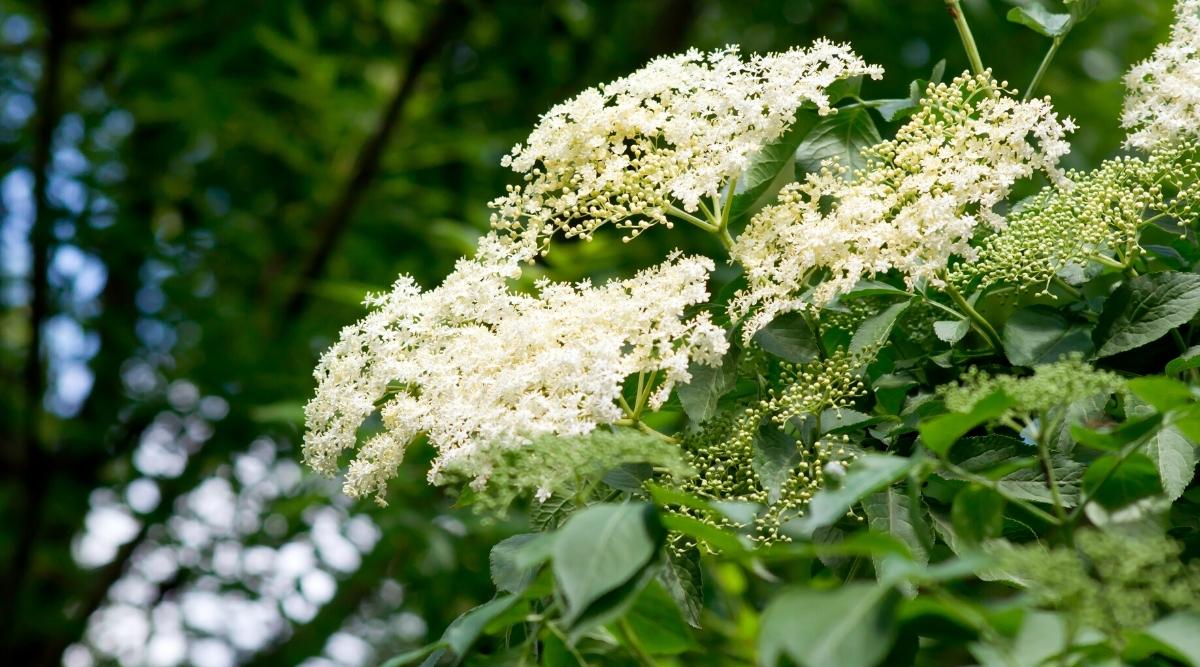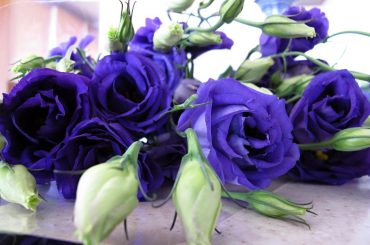Table of Contents
Pure sheer elegance and timeless beauty of white flowers add a serene vibe to any garden. Creating a calm and stunning atmosphere surrounded by white flowering trees is a dream come true for most gardeners. But choosing the right tree or plant for your garden can be a daunting task as there are thousands of choices available out there.
In this article, we will walk you through 12 beautiful white flowering trees that will help you create a magnificent landscape. From the delicate beauty of camellia to the fragrant beauty of Grandiflora, we are all set to explore the unique charm these trees will bring to your place.
Get ready to be inspired!
1. Syringa Reticulata
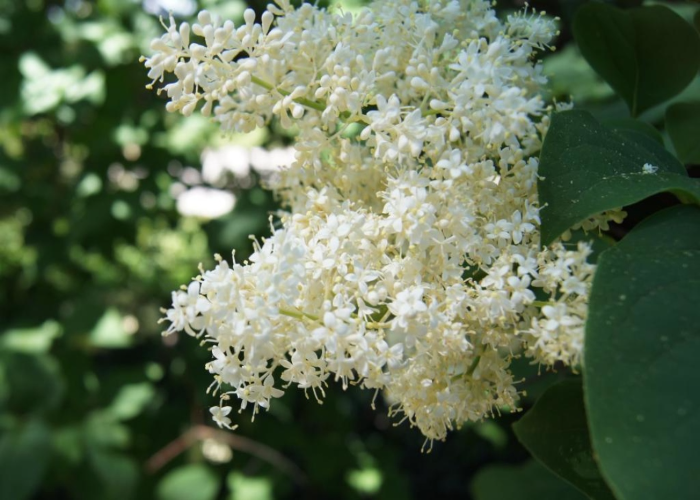
Japanese Tree Lilac or Syringa Reticulata belongs to Oleaceae, which is native to Eastern Asia and is grown as an ornamental tree in Europe and North America.
This is a beautiful deciduous tree that grows up to 30 ft tall and spreads up to 20 ft wide. This is considered the largest species of lilac that grows as a tree rather than a shrub. This tree produces white and creamy white, strongly fragrant flowers in clusters.
These trees grow in full sunlight and thrive in well-drained, moist, neutral, acidic soil. These trees cannot produce more flowers when grown in partial sunlight. Though these plants can survive in less fertile soil, too, they do well in fertile soil in the Spring season. To avoid frequent watering mulch to retain moisture with compost and pebbles.
They usually bloom in early summer and prune moderately in Spring to avoid multi-branching. These trees are highly resistant to powdery mildew and are highly tolerant to urban pollution and drought, making them a popular choice for city landscaping.
These trees are also known for their traditional medicinal properties, which can treat arthritis and respiratory infections.
2. Robinia Pseudoacacia
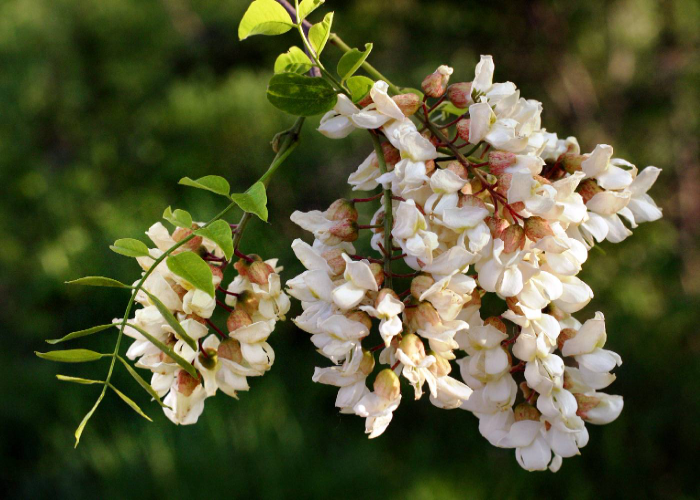
Robinia Pseudoacacia, also known as Black Locust, is a fast-growing deciduous tree with scented-like flowers. This tree has gorgeous leaves with 5-11 pairs of leaflets which turn yellow in the fall before shedding. They usually bloom in late Spring and early summer, producing dense clusters of white flowers that are 8 inches long.
This is an easy-growing plant which can withstand any soil conditions, even in low fertile soil. They thrive in full sunlight in medium-drained soil; once well set, they become drought-tolerant.
These trees usually grow by self-seeding and root-sucking. Prune is needed in late summer and early fall to prevent bleeding and to remove suckers. Clean the surroundings of the tree regularly as they grow rapidly from the seeds of the tree.
This tree is considered to be toxic to humans and animals like dogs, cats and horses. It is recommended to be careful while handling this tree. Black Locust flowers attract honeybees and hummingbirds and also provide nesting cavities for woodpeckers.
3. Yoshino Cherry
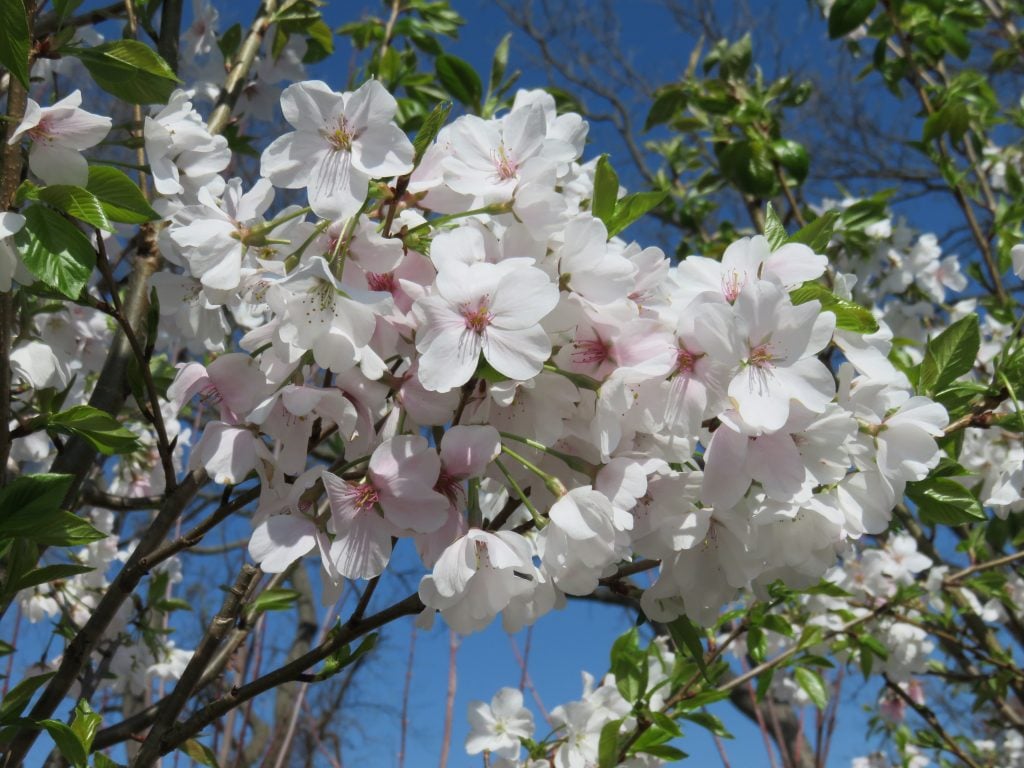
Prunus x yedoensis is a darling hybrid of Prunus x speciosa (Oshima Cherry) and Prunus x itosakura (Edu higan); it inherits Oshima’s ability to grow rapidly and white flowers and Edu higan’s ability to bloom before the leaves unfold and the large size. Though this plant is widely popular in Japan and has been grown for centuries, it was introduced to the UK in the 1900s and quickly became very famous.
Yoshino is a small, fast-growing deciduous tree that grows up to 39 ft tall, with bronze-coloured leaves that turn green in summer. This tree blooms in early to mid-spring and will last up to 3 to 4 weeks. Depending on the cultivars, the flowers are white or pink, single or double. Yoshino thrives in full sunlight and particle shade and can adapt to all kinds of soil and temperatures; though they are not drought-tolerant but can still sustain in hot and humid areas.
Yoshino makes a perfect lawn, garden and pathway tree because of its lustrous bloom, dark reddish-brown bark and fascinating nature of attracting birds. These plants are usually pests and disease free, but look for leaf spots, moths, caterpillars etc. The blackberries produced by Yoshino are loved by birds.
4. Blackthorn
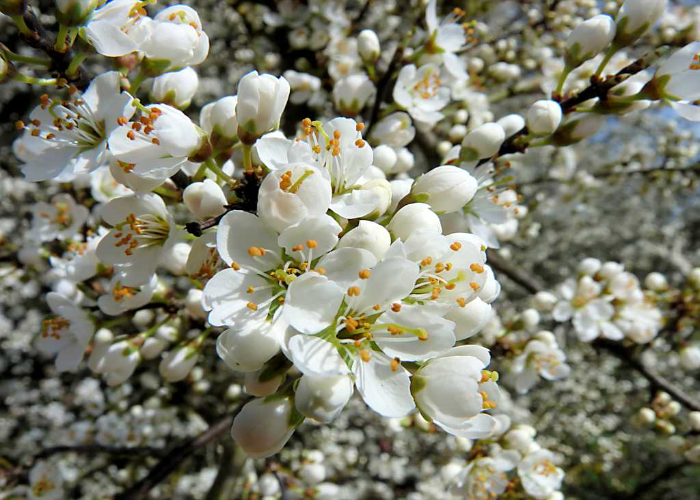
Prunus Spinosa, also known as Blackthorn or sloe, belongs to the family of Rosaceae, which is native to Europe, Western Asia and North Africa. This is a small thorny deciduous tree which grows up to 16 ft tall and blooms white flowers in early Spring. The berries produced in Autumn are edible and used to make jam and pies. The wood is used to make canes and tool handles and is also used in the fireplace as it burns slowly with little smoke.
Blackthorn thrives under full sunlight, partial shade, and moist, well-drained, neutral, alkaline soil. These trees are susceptible to caterpillars, moths and aphids, which leave silver leaves. Due to its long and strong thorns, the dead blackthorn wood is used to hedge animals.
The Blackthorn is said to have a long history of traditional medicinal values that can treat Digestive issues such as diarrhoea and stomach cramps, and the rich antioxidant nature helps with the Immune System. It is also believed that it helps with cardiac disorders, respiratory issues and inflammations.
5. Whitebeam tree
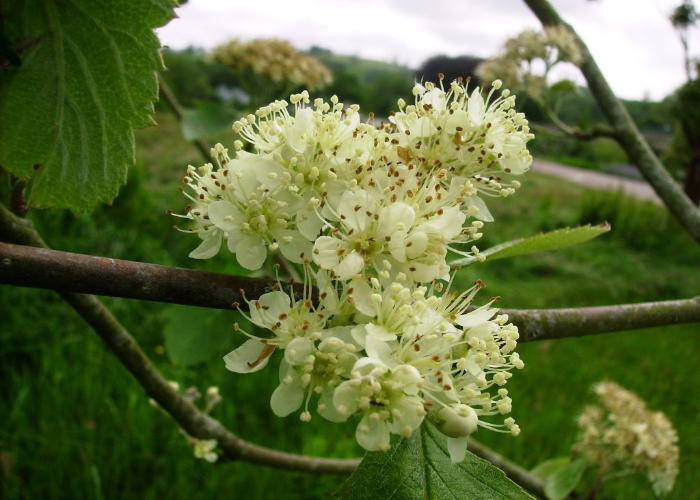
Sorbus aria, commonly known as Whitebeam, belongs to the family of Rosaceae and is native to the UK. Whitebeam is a domestic deciduous tree with broad leaves and is a popular ornamental tree grown in parks and gardens. The hermaphrodite (each flower has both male and female reproductive parts) nature of the flowers makes it more interesting and attracts insects to pollinate.
Whitebeam produces rich cream-white flowers in clusters in the month of Spring and produces red-coloured berries in late summer or Autumn, which are favourite to garden birds. This tree thrives to full sunlight and particle share in humus-rich, moist, well-drained soil in neutral, alkaline nature. These trees are easy to care for and are highly tolerant to less fertile soil, urban pollution and dry conditions.
These trees are susceptible to diseases like apple canker, silver leaf, and honey fungus; it is also important to look out for blister mites and aphids.
6. Kousa Dogwood
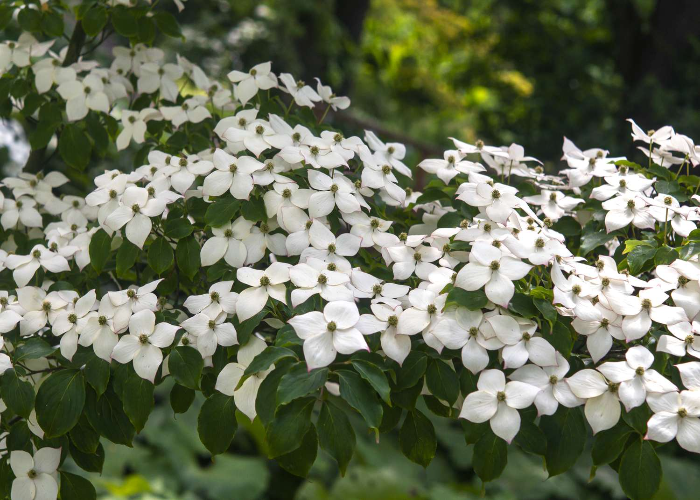
Cornus kousa, whose common names include kousa Dogwood, kousa, and Chinese dogwood, are native to East Asia and are widely cultivated as ornamental trees. Dogwood is known for its spectacular autumn leaves and creamy white flowers from May to June. The berries produced are edible; though they taste bitter, they are used in pies and jams.
Dogwood is a deciduous flowering tree which grows up to 30 ft tall and wide. These trees thrive in full and partial sunlight in rich, well-drained soil. Though these plants do well in full sunlight, the leaves suffer scorch if exposed to sunlight; it is recommended to plant in a location with more morning light and afternoon shade. It is important to make sure the soil is well prepared with organic matter that is consistently moist but not wet. Until roots are established, young trees need weekly watering, and these trees do well in dry conditions, too, once they mature.
Dogwood fruits or Cornus Berries have traditional health benefits that can improvise kidney functioning, tone the liver, and control blood disorders and bleeding; they also act as anti-inflammatory agents.
7. Star Magnolia
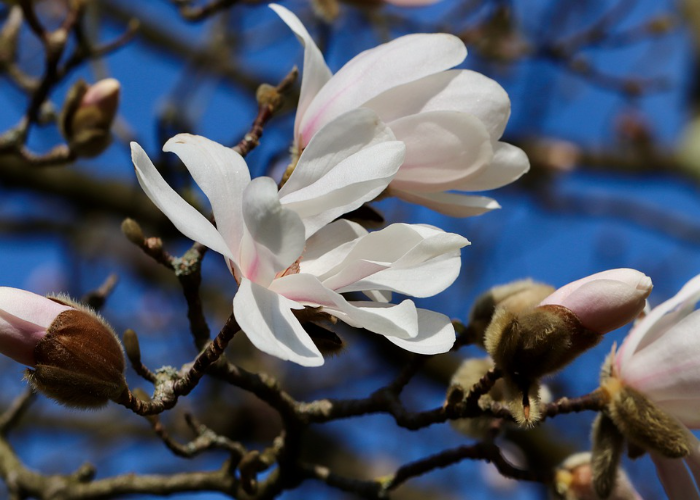
Magnolia Stellata, commonly known as Star Magnolia, is a slow-growing tree that is native to Japan and was introduced to Europe in the late 1800s. This tree grows up to 20 ft tall and spreads up to 15 ft wide. This tree bears large white showy flowers that bloom in early Spring even before the leaves open.
This tree grows well in full and partial sunlight but does well if it receives a minimum of 4 hours of direct sunlight daily. Star Magnolia can grow in acidic, moist, well-drained and sandy soil; since they are low maintenance, they can tolerate droughts and grow with less frequent watering.
Star Magnolia needs no fertilizers, but if you choose to fertilize, use all-purpose fertilizers in early Spring before the blooming season and phosphorus fertilizers to strengthen the root system.
This plant tends to grow multi-stemmed, and the flowers bloom on old wood and prune less after the blooming season to avoid losing next year’s bloom.
8. Royal White Redbud
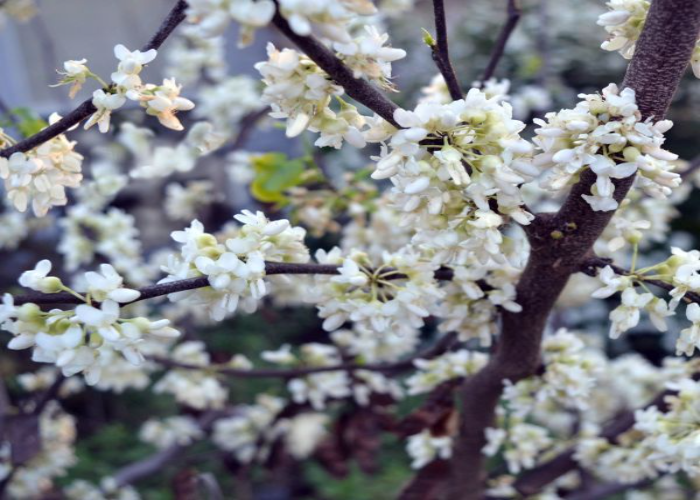
Cercis canadensis, commonly known as Royal White Redbud, is a small deciduous tree that blooms on bare branches in Spring. The green leaves turn yellow and shed in Autumn; right before the leaves appear again, this tree displays showy large white flowers on bare branches in early Spring.
This tree grows to 25 ft and spreads to 25 ft wide. This tree survives and adapts to most soils like moist, well-drained, alkaline types; they thrive in full sunlight and partial shade. Royal While requires low watering and can tolerate salt water too.
Redbuds do not usually require pruning, but if needed, do it after blooming to remove dead, dying branches. Also, look out for pests and diseases and treat them using natural ingredients like horticultural oils.
9. Hydrangea Grandiflora
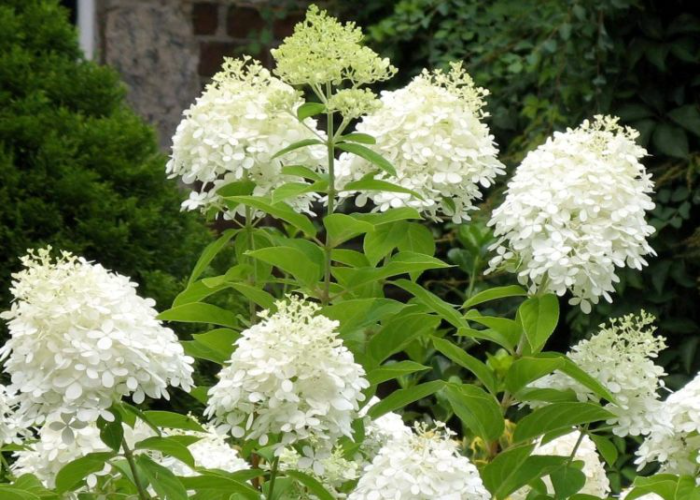
Hydrangea paniculata Grandiflora, commonly known as Peegee Hydrangea, is a hardy deciduous tree with large, showy flowers in clusters. Grandiflora usually grows up to 10 ft and spreads up to 15 ft wide.
These trees bloom in midsummer, and the snowy white flowers become pink-tinged as they approach fall. The oval-shaped dark green leaves turn yellow-reddish-purple in the fall. This plant thrives in full sunlight and partial shade and can survive in rich, moist, well-drained soil. When in summer, afternoon shade is recommended for this tree to survive. These plants are easy to grow and maintain as they can tolerate heat, humidity and urban environments.
For better blooming, it is advised to prune in late winter or early Spring. Grandiflora foliage is allergic to skin and toxic to animals like dogs, cats and horses if ingested.
10. White Fringe tree
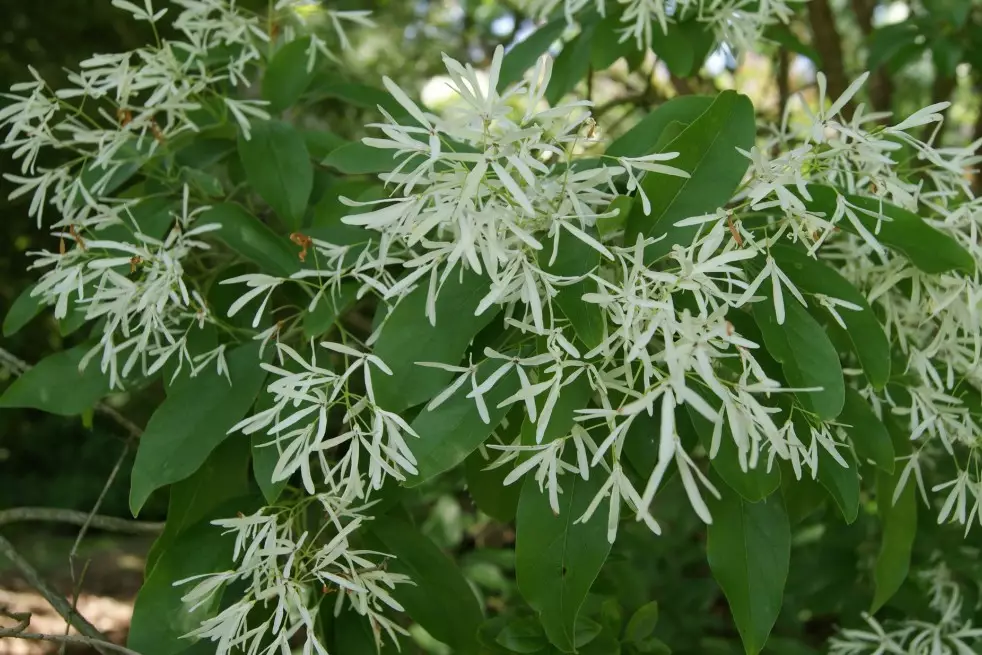
Chionanthus virginicus, also known as the White Fringe tree, belongs to the family of Oleaceae. Fringe Tree is a native plant in North America and was introduced to the British in the 1730s.
This is a small deciduous flowering plant that produces white fragrant clusters of showy flowers. The oval dark green leaves turn yellow in Autumn before falling. These plants grow up to 13 ft tall and 10 ft spread and bloom in June.
These plants thrive in full sunlight and well-drained, moist soil. This tree doesn’t do well in cold and shady areas. Fringes do not usually need pruning, but to control multi-branching, they need to be lightly trimmed in the first two springs. These trees are easily susceptible to serious pests and diseases, look out for them regularly and use insecticide sprays or oils to prevent the damage.
11. Camellia
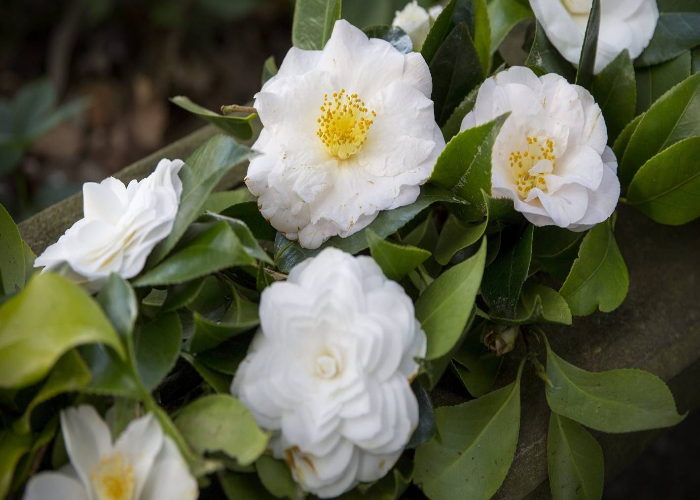
Camellia Japonica Yukimi Guruma, also known as White Swan. It is a vigorous flowering tree that produces white flowers with yellow anthers. White Swan is a native tree in Japan and was introduced to the UK in the early 1790s, but it gained popularity in the early 1800s amongst exotic gardeners.
These plants thrive in full sunlight and partial shade in moist, well-drained neutral, acidic soil. They grow up to 15 ft tall and spread. These trees bloom fragrant, rich white single and double-layered flowers based on the variety in the Spring. Pruning is not required, but deadheading after blooming will help.
White swans are susceptible to scale insects, aphids and diseases like camellia galla and camellia petal blight.
12. Bradford Flowering Pear
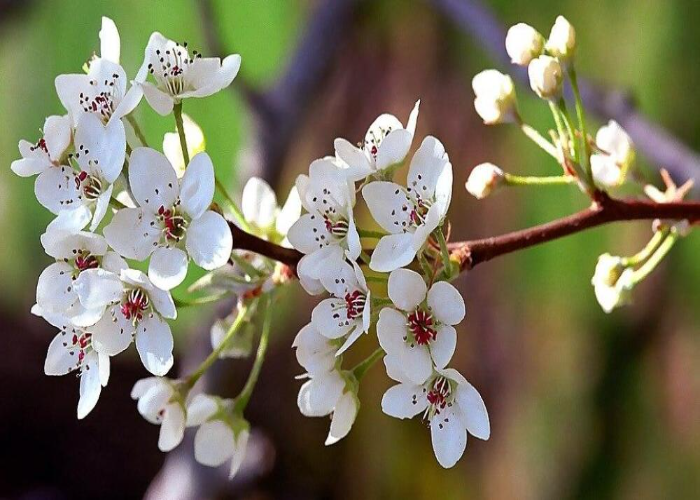
Pyrus calleryana or Callery Pear, commonly known as Bradford pear, is a species of pear tree belonging to Rosaceae, native to China and Vietnam. This is a fast-growing ornamental tree with a spectacular white bloom display and long-lasting autumn colour.
These trees bear pears too, which are not considered ornamental but are disliked for their odour. This is one of the first flowering trees in Spring; though these plants are easy to grow and easy to care for, they are definitely not a choice for your garden.
This tree grows up to 30 ft tall and is grown as street trees. These trees thrive in full sunlight and are adapted to all kinds of soils.
Even though the flowers are very attractive and beautiful, they are not recommended to grow.
Conclusion
We hope this blog will help you pick the right white beauty for your garden. Whether you are looking to add elegance to your garden or just trying to create a calm environment in your own space, this blog on 12 white flowering trees will bring beauty.
But choosing the right option is just the start of the game; taking and maintaining the tree is also an overwhelming task. Though most of these trees are low maintenance and easy to care for, they need your time and attention.
Even though you are a beginner, this blog is going to help you pick your favourite plant. White flowers are not boring; the unique charm and beauty of these flowers bring tranquillity to any outdoor space.
Now that you know what you want in your garden don’t be afraid to experiment!

